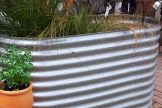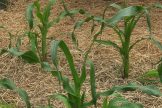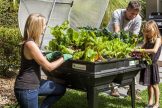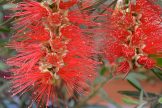
January, Biderap – The hot dry season in the local indigenous language. A time for the common brown butterfly and dry tussock grass. A time to harvest tomatoes, beans, zucchini and late apricots. A time for Kangaroo paw to put on an awesome show of brilliant colour. A time to sit back and relax in the shade of a beautiful tree and contemplate all the previous year’s work in the garden, and dream of adventures to come.
Edibles to plant in Melbourne in January.
Below is a list of edible gardening seeds and seedlings that can be planted in January. Please keep in mind that this list has been developed for Melbourne’s climate. Some of the plants indicated will be either right at the start or the end of their ideal planting season, click the links to the factsheets for more detailed planting information.
 – Seeds – Seeds – Seedlings – Seedlings
|
 – Tubers / Crowns – Tubers / Crowns – Companion Plants – Companion Plants
|
 – Prone to Cabbage Butterfly – Prone to Cabbage Butterfly
|
Alyssum   Amaranth  Angelica  Artichokes (Globe)  Artichokes (Jerusalem)  Basil   Beans (climbing)   Beans (dwarf)   Beetroot   Borage   Burdock  Canteloupe  Capsicum  Cardamom Leaf  Carrot   Celeriac   Celery   Chamomile   Chervil   Chilli Peppers  Chives    Coriander   Cosmos   Cress  
|
Cucumber  Curry Plant  Daikon  Dill  Echinacea    Eggplant  Feverfew   Good Bug Mix   Horseradish  Kale   Leeks   Lemon Balm  Lettuce  Licorice Herb  Lovage   Marigold   Marjoram   Mint  Nasturtiums   Oregano   Parsley   Parsnip  Pumpkin  Radish  
|
Rhubarb Rocket / Arugula  Rockmelon  Rosemary   Saffron Crocus (bulbs) Sage  Salad Burnett  Silverbeet   Savory   Sorrel  Spring Onion   Squash  Sunflower  Sweet Corn   Tarragon  Thyme   Tatsoi  Tomatoes  Turnip  Warrigal Greens  Watercress   Wasabi  Watermelon  Zucchini 
|

Mulch and Irrigation
Summer is the time to enjoy the benefits of having installed an irrigation system, and to feel slightly smug about doing so. However, it’s also the time to give it a thorough look-over, as the increased foliage your plants pushed out during their spring growth may have blocked your irrigation system’s spray patterns. I am a BIG fan of having a controller that I typically set on a minimal maintenance watering program, and I then manually set it to do an extra run on hot days – I press two buttons and hey presto, it’s watered my garden for me. This doesn’t just save on work and time, but is more economical as well – the first summer that I converted to a drip system, my water bill dropped by about 40%.
Through sad experience, I know that I often forget to water pot plants in crucial times, so all my pot plants are also linked to my automatic irrigation system. I’ve had it set up like this for five years or so, and it’s really worked out well – other friends like to potter around with a watering can or hose, but not me. In fact, the only time I do that is when I am giving them a liquid feed.

Lastly, summer is also the time to enjoy the benefits of laying down some mulch (and to once again feel slightly smug about doing so). After all, laying down some mulch reduces moisture loss from the soil surface and thus aids plant growth, while also reducing the need to water as much and lessening the chance of the soil drying out and cracking. It’s not too late to lay some down if you haven’t already, and you’ll thank yourself for it come mid-summer, so what are you waiting for?
For more information on irrigation systems and mulching head to the following factsheets; Mulching for a Healthy Garden and Watering Systems.

Other sundry summer things
Although the rule of thumb is to back off on pruning or feeding plants over the summer months, here in the nursery we often tend to give our roses a light prune and a feed in January, in order to to get a nice autumn flush of flowers. You can also do this in your garden as long as you don’t go too bananas – after all, it’s really just an enthusiastic form of deadheading.
You can fertilise your garden over summer BUT it’s essential to avoid synthetic fertilisers – the hot weather (and especially the very hot weather) can cause these fertilisers to suddenly release a large amount of nitrogen, which can then cause some root burn. So instead of using synthetics, it’s best to instead choose manure, worm castings or seaweed based fertilisers, which will ensure a gentle feed over summer.
Even if summer is your main holiday time you can still do some planting, as long as you commit to watering more heavily until these new plants are well rooted into your garden and are thus more able to take care of themselves. Over summer in the nursery, we water every bench every day, as the only things helping the plants survive are the soil in the pot and the water we give them – when it’s really hot, many of them will get a second water in the late afternoon. The easiest way to have confidence in your summer watering is to use common sense – if it’s hot and dry enough to make you sweat or remark on it, then they’ll more than likely need a drink.
Enjoy your summer garden, you’ve worked hard for it all year!





